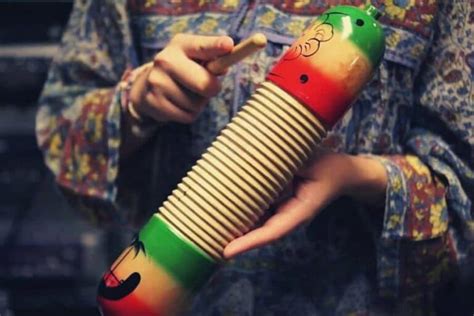An Enchanting Overview of the Güiro
The güiro, a versatile and captivating percussion instrument, has captivated music lovers for centuries. Its distinctive rasping sound and vibrant cultural roots make it an essential component in various musical genres. This comprehensive article delves into the intriguing world of the güiro, unveiling its rich history, diverse applications, and captivating sound.

Unveiling the Güiro’s Origins
The güiro’s origins can be traced back to pre-Columbian civilizations in Central and South America. Initially crafted from dried gourds, these early iterations were adorned with notches or serrations. This primitive design created a resonant sound when scraped with a stick or bone.
Traditional Uses: A Musical Journey
Traditionally, the güiro played a pivotal role in indigenous rituals and ceremonies. Its rhythmic accompaniment enhanced storytelling and invoked spirits. In various Afro-Caribbean cultures, the güiro found a place in folk music, accompanying genres such as salsa, merengue, and bomba.
Contemporary Applications: Embracing Modern Sounds
Today, the güiro’s versatility extends beyond traditional settings. It has become an indispensable instrument in modern music, enriching genres such as jazz, rock, and pop. Its distinctive sound adds a unique rhythmic texture to various musical arrangements.
An Instrument of Versatility: Exploring the Güiro’s Roles
Rhythm-Keeper:
The güiro’s primary role is to provide rhythmic accompaniment. Its crisp, scratchy sound cuts through the mix, propelling the music forward.
Melodic Canvas:
In certain musical contexts, the güiro transcends its rhythmic role and becomes a melodic instrument. Skilled players can extract melodies and phrases by scraping the notches with varying speeds and pressures.
Textural Enhancer:
The güiro’s raspy texture adds depth and interest to musical arrangements. Its ability to create a percussive “bed” enhances the overall sound of the music.
Embracing the Abundance of Güiro Variations
Gourd Güiro:
The traditional gourd güiro remains a popular choice. Its organic shape and natural resonance produce a warm, earthy sound.
Wooden Güiro:
Wooden güiros offer a brighter, more articulate sound with less overtones. They are commonly used in modern music settings.
Metal Güiro:
Metal güiros, such as those made from steel or aluminum, produce a sharp, piercing sound that cuts through dense arrangements.
The Art of Playing the Güiro
Mastering the güiro requires a combination of technique and feel. Here are some essential playing tips:
- Hold: Grip the güiro securely with one hand, keeping the notches facing up.
- Scrape: Use a stick or spoon to scrape the notches with a downward motion, creating the characteristic rasping sound.
- Vary Pressure: Applying different amounts of pressure will produce variations in volume and tone.
- Explore Patterns: Practice rhythmic patterns to develop dexterity and coordination.
The Güiro’s Impact: A Catalyst for Musical Expression
The güiro has left an undeniable mark on the global music scene. Its rhythmic vitality and cultural significance continue to inspire and captivate musicians and audiences alike.
Benefits of Incorporating the Güiro into Your Musical Arsenal
Enhances Rhythmic Complexity:
The güiro’s intricate patterns add depth and complexity to musical arrangements.
Enriches Cultural Expression:
Embracing the güiro connects musicians to its rich cultural heritage.
Amplifies Musical Creativity:
The güiro’s versatility encourages experimentation and fosters musical innovation.
Common Mistakes to Avoid When Playing the Güiro
Over-Scraping:
Excessive scraping can produce an unpleasant, harsh sound. Practice moderation to achieve a balanced tone.
Inconsistent Rhythm:
Maintaining a steady rhythm is crucial. Avoid rushing or dragging the tempo.
Poor Grip:
A secure grip ensures control and accuracy while playing.
Conclusion: The Enduring Legacy of the Güiro
The güiro, a timeless musical instrument, has etched its mark on the fabric of global music. Its vibrant rhythms and cultural significance continue to resonate, inspiring generations of musicians. As a symbol of rhythmic vitality and cultural expression, the güiro remains an indispensable tool for those seeking to unlock the essence of rhythmic joy.
Appendix: Tables for Reference
Table 1: Types of Güiros
| Type | Material | Sound Characteristics |
|---|---|---|
| Gourd | Dried gourd | Warm, earthy tone |
| Wooden | Wood | Bright, articulate sound |
| Metal | Steel or aluminum | Sharp, piercing tone |
Table 2: Güiro Playing Techniques
| Technique | Description |
|---|---|
| Scraping | Using a stick or spoon to create the rasping sound |
| Varying Pressure | Applying different amounts of pressure to produce variations in volume and tone |
| Exploring Patterns | Practicing rhythmic patterns to develop dexterity and coordination |
Table 3: Benefits of Incorporating the Güiro into Music
| Benefit | Description |
|---|---|
| Enhances Rhythmic Complexity | Adds depth and complexity to musical arrangements |
| Enriches Cultural Expression | Connects musicians to its rich cultural heritage |
| Amplifies Musical Creativity | Encourages experimentation and fosters musical innovation |
Table 4: Common Mistakes to Avoid When Playing the Güiro
| Mistake | Description |
|---|---|
| Over-Scraping | Excessive scraping can produce an unpleasant, harsh sound |
| Inconsistent Rhythm | Maintaining a steady rhythm is crucial |
| Poor Grip | A secure grip ensures control and accuracy |
